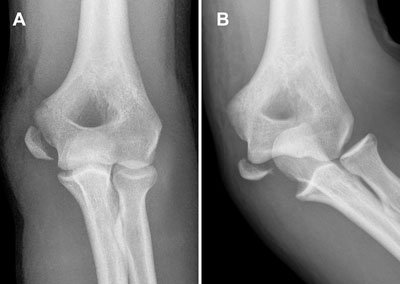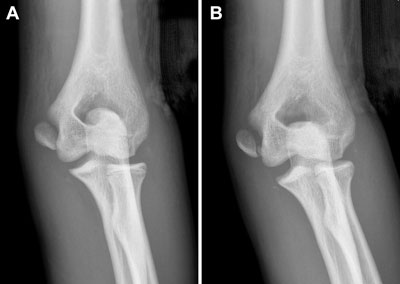Nonoperative medial epicondyle humeral fracture care slightly better than surgery
Even in overhead athletes, brief immobilization was successful at 2 years follow-up with a minimally displaced fracture and a stable elbow.
Although both operative and nonoperative treatment of displaced medial humeral epicondyle fractures in adolescents helped them return to sport, provided a high degree of post-treatment satisfaction and good clinical outcomes, nonoperative treatment may offer an edge, according to results of a retrospective study.

Study investigators found slightly better DASH scores and functional outcomes for patients treated nonoperatively, according to J. Todd R. Lawrence, MD, PhD.
“We have provided the first evidence that nonoperative treatment in the properly selected patient can allow full return to competitive sports in overhead athletes,” Lawrence said at the American Academy of Orthopaedic Surgeons annual meeting.
Similar groups
Lawrence and colleagues identified 20 teenage patients treated between 2001 and 2005 who met the inclusion criteria of having an isolated displaced medial epicondyle humerus fracture and 2 years follow-up with DASH scores and subjective questionnaires. Fourteen patients underwent operative treatment and six were treated with cast immobilization.
The groups were similar, but in the operative group six patients had total elbow dislocations and one later needed a capsular release.
|
Images: Lawrence JT |
“The trend was toward greater amounts of fracture displacement in patients treated operatively,” Lawrence noted.
In all, 14 patients were overhead athletes; seven were pitchers who fractured their elbows while pitching.
DASH results
Investigators found DASH scores and functional outcomes were slightly superior in the nonoperative group, which had DASH outcomes of 0.12 ± 0.33 compared to 1.33 ± 1.81 in the operative group at 2 years.
“Both treatments were associated with very good clinical outcomes,” Lawrence said.
Investigators found all patients were completely satisfied with their results.
An outcomes analysis of the 14 competitive overhead athletes revealed they all returned to their sports, along with a slight trend toward greater improvement in the nonoperative group. In the seven pitchers — four treated operatively and three treated nonoperatively — Lawrence and colleagues also observed the same trend toward slightly better results with nonoperative care.
|
|
Lawrence explained this research had important limitations, including a small sample studied retrospectively and the likelihood post-treatment protocols varied due to multiple treating physicians.
In response to an audience question about patient selection for each treatment, Lawrence said the fact surgeons typically prefer operative treatment for widely displaced or unstable elbows and would only treat minimally displaced medial humeral avulsion fractures nonoperatively may have added significant selection bias.
“We would caution you that because of the limitations of this study design, we cannot determine the superiority of one over the other and recommend that treatment still be individualized to the patient with careful discussion of the risks and benefits of treatment,” he said.
For more information:Reference:
- J. Todd. R. Lawrence, MD, PhD, and Theodore J. Ganley, MD, can be reached at Children’s Hospital of Philadelphia, 2 Wood Building, Department of Orthopaedics, Philadelphia, PA 19103; 267-970-6420; e-mail: j.todd.lawrence@gmail.com. He has no direct financial disclosures related to products or companies mentioned in this article.
- Lawrence JTR, Ganley TJ, Macknin J, et al. Return to sports after medial epicondyle fracture in teens: Operative vs. non-operative treatment. Paper #593. Presented at the American Academy of Orthopaedic Surgeons 76th Annual Meeting. Feb. 25-28, 2009. Las Vegas.


